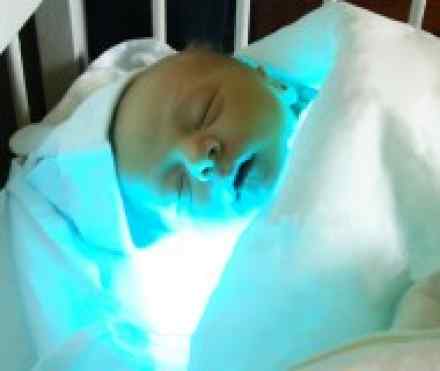
What is it?
- Infant jaundice is a yellow discoloration in a newborn baby's skin and eyes. The condition occurs because the baby's blood contains an excess of bilirubin, a yellow-colored pigment of red blood cells.
- Infant jaundice is a common condition, particularly in babies born before 36 weeks gestation (preterm babies). Infant jaundice usually occurs because a baby's liver isn't mature enough to get rid of bilirubin in the bloodstream. In some cases, an underlying disease may cause jaundice.
- Treatment of infant jaundice often isn't necessary, and most cases that need treatment respond well to noninvasive therapy.
Symptoms
Signs of infant jaundice usually appear between the second or fourth day of life and include:
- Yellowing of the skin
- Yellowing of the eyes
You'll usually notice jaundice first in your baby's face. If the condition progresses, you may notice the yellow color in his or her eyes, chest, abdomen, arms and legs.
The best way to check for infant jaundice is to press your finger gently on your baby's forehead or nose. If the skin looks yellow where you pressed, it's likely your baby has jaundice. If your baby doesn't have jaundice, the skin color should simply look slightly lighter that its normal color for a moment.
It's best to examine your baby in good lighting conditions, preferably in natural daylight.
Causes
Bilirubin, the agent that causes the yellow color of jaundice, is a normal part of the waste produced when "used" red blood cells are broken down. The liver filters bilirubin from the bloodstream and releases it into the intestinal tract. Bilirubin is removed from the body primarily in the stool. Before birth, a mother's liver removes bilirubin from the baby's blood.
A newborn infant has a large amount of red blood cells, and the rate at which they are produced and broken down is relatively fast. Also, the liver of a newborn is immature and often can't remove bilirubin quickly enough. Jaundice due to these normal newborn conditions, or physiologic jaundice, typically appears on the second or third day of life.
Excess bilirubin in the blood is called hyperbilirubinemia. Although jaundice is actually a sign of hyperbilirubinemia, the term "jaundice" is often used as shorthand for the longer term.
Other causes
A baby may have an underlying disorder that is causing jaundice. In these cases, jaundice often appears much earlier or much later than physiologic jaundice. Diseases or conditions that can cause jaundice include:
- Internal bleeding (hemorrhage)
- An infection in your baby's blood (sepsis)
- Other viral or bacterial infections
- An incompatibility between the mother's blood and the baby's blood
- A liver malfunction
- An enzyme deficiency
- An abnormality of your baby's red blood cells
Risk factors
Major risk factors for jaundice, particularly severe jaundice that can cause complications, include:
- Premature birth. A premature baby may not be able to process bilirubin as quickly as full-term babies do. Also, he or she may feed less and have fewer bowel movements. These conditions result in less bilirubin eliminated in your baby's stool.
- Bruising during birth. Sometimes babies are bruised during the delivery process. If your newborn has bruises, he or she may have a higher level of bilirubin from the breakdown of more red blood cells.
- Blood type. If your blood type is different from your baby's, your baby may have received antibodies from you through your placenta that cause his or her blood cells to break down more quickly.
- Breast-feeding. Breast-fed babies have a higher risk of jaundice, particularly those who are having difficulty nursing or not getting enough nutrition from breast-feeding. Dehydration and low intake of calories from poor breast-feeding may contribute to the onset of jaundice.
Complications
Severe jaundice, if left untreated, can cause serious complications.
Acute bilirubin encephalopathy
Bilirubin is toxic to cells of the brain. If a baby has severe jaundice, there's a risk of bilirubin passing into the brain, a condition called acute bilirubin encephalopathy. Prompt treatment may prevent significant permanent damage.
The following signs may indicate acute bilirubin encephalopathy in a baby with jaundice:
- Listless, sick or difficult to wake
- High-pitched crying
- Poor sucking or feeding
- Backward arching of the neck and body
- Fever
Kernicterus
Kernicterus is the syndrome that occurs if acute bilirubin encephalopathy causes permanent damage to the brain. Kernicterus may result in:
- Involuntary and uncontrolled movements (athetoid cerebral palsy)
- Permanent upward gaze
- Hearing loss
- Intellectual impairment
Diagnosis
Your doctor will likely diagnose infant jaundice on the basis of your baby's appearance. However, it's not possible to judge the severity of jaundice based on appearance alone. Your doctor will need to measure the level of bilirubin in your baby's blood. The level of bilirubin, or severity of jaundice, will determine the course of treatment.
The tests for bilirubin levels include:
- A laboratory test of a sample of your baby's blood
- A skin test with a device called a transcutaneous bilirubinometer, which measures the reflection of a special light shone through the skin
Your doctor may order additional blood tests or urine tests if there's evidence that your baby's jaundice is caused by an underlying disorder that needs to be treated.
References:
http://emedicine.medscape.com/article/974786-overview
http://www.nhs.uk/conditions/Jaundice-newborn/Pages/Introduction.aspx
https://www.nlm.nih.gov/medlineplus/ency/article/001559.htm
http://kidshealth.org/en/parents/jaundice.html
http://www.healthline.com/health/newborn-jaundice
http://www.emedicinehealth.com/newborn_jaundice/article_em.htm

